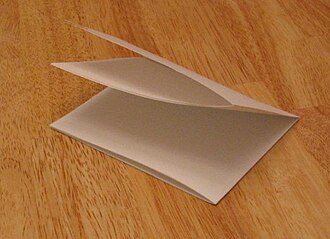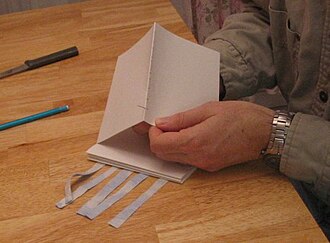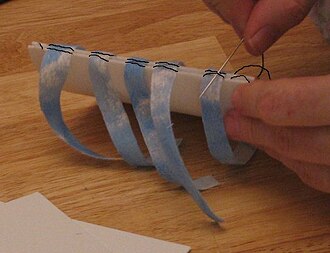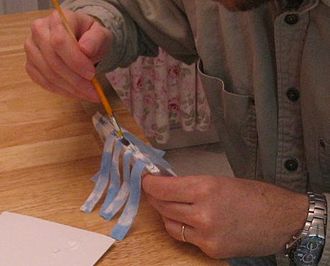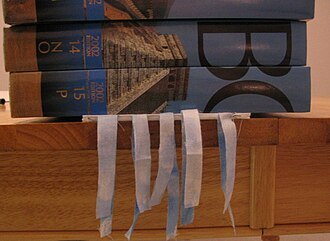Difference between revisions of "AY Honors/Bookbinding/Answer Key"
m |
|||
| Line 4: | Line 4: | ||
Much of the material in this book was drawn from [http://wikipedi.org Wikipedia], the Free Encylopedia. | Much of the material in this book was drawn from [http://wikipedi.org Wikipedia], the Free Encylopedia. | ||
| − | ==Be able to identify the following terms: == | + | ==1. Be able to identify the following terms: == |
# '''Foredge:''' the fore edge of a book, that is, the edge opposite the spine. | # '''Foredge:''' the fore edge of a book, that is, the edge opposite the spine. | ||
# '''Gutter:''' the inner margin of a pair of facing pages. This would be the right margin of an even-numbered page (which is always found on the left side) and the left margin of an odd-numbered page (which is always found on the right). | # '''Gutter:''' the inner margin of a pair of facing pages. This would be the right margin of an even-numbered page (which is always found on the left side) and the left margin of an odd-numbered page (which is always found on the right). | ||
| Line 20: | Line 20: | ||
# '''Buchram:''' the cloth used on the outside of a book cover. | # '''Buchram:''' the cloth used on the outside of a book cover. | ||
| − | ==Describe the difference between the following binding methods: == | + | ==2. Describe the difference between the following binding methods: == |
# '''Perfect binding''' A paperback or soft cover book consists of a number of signatures or individual leaves between covers of much heavier paper, glued together at the spine with a strong flexible glue; this is sometimes called perfect binding. Mass market paperbacks and pulp paperbacks are small (16mo size), cheaply made and often fall apart after much handling or several years. | # '''Perfect binding''' A paperback or soft cover book consists of a number of signatures or individual leaves between covers of much heavier paper, glued together at the spine with a strong flexible glue; this is sometimes called perfect binding. Mass market paperbacks and pulp paperbacks are small (16mo size), cheaply made and often fall apart after much handling or several years. | ||
# '''Hard bound''' A hardbound or hard cover book has rigid covers and is stitched in the spine. Looking from the top of the spine, the book can be seen to consist of a number of signatures bound together. When the book is opened in the middle of a signature, the binding threads are visible. Modern hardcover books are typically of octavo size, though they are often smaller or larger. | # '''Hard bound''' A hardbound or hard cover book has rigid covers and is stitched in the spine. Looking from the top of the spine, the book can be seen to consist of a number of signatures bound together. When the book is opened in the middle of a signature, the binding threads are visible. Modern hardcover books are typically of octavo size, though they are often smaller or larger. | ||
| Line 27: | Line 27: | ||
# '''Saddle stitch''' Stapling through the center fold, also called saddle-stitching, joins a set of nested folios into a single magazine issue. Most American comic books fall into this category. | # '''Saddle stitch''' Stapling through the center fold, also called saddle-stitching, joins a set of nested folios into a single magazine issue. Most American comic books fall into this category. | ||
| − | ==Perform the following== | + | ==3. Perform the following== |
| − | ===Bind a single signature hand binding "manuscript".=== | + | ===3a. Bind a single signature hand binding "manuscript".=== |
A '''manuscript''' is an original copy of an author's work. Manuscripts are often submitted in the form of typewritten (or computer printed) sheets of paper. Sometimes the manuscripts are two-sided, and sometimes they are single-sided. | A '''manuscript''' is an original copy of an author's work. Manuscripts are often submitted in the form of typewritten (or computer printed) sheets of paper. Sometimes the manuscripts are two-sided, and sometimes they are single-sided. | ||
| Line 39: | Line 39: | ||
Once the paste has dried, each sheet is carefully folded along the center of the overlapping sections. The manuscript will resist folding at this seam because the paper is double-thick there. Nonetheless, this is where the fold should be made. A bone folder makes this task easier. The folded sheets are then nested together to form a ''signature'', and the signature is then ready to sew. | Once the paste has dried, each sheet is carefully folded along the center of the overlapping sections. The manuscript will resist folding at this seam because the paper is double-thick there. Nonetheless, this is where the fold should be made. A bone folder makes this task easier. The folded sheets are then nested together to form a ''signature'', and the signature is then ready to sew. | ||
| − | ===Bind a blank book using at least four signatures and a permanent cloth hard board binding, using a "case" method. === | + | ===3b. Bind a blank book using at least four signatures and a permanent cloth hard board binding, using a "case" method. === |
====Fold the signatures==== | ====Fold the signatures==== | ||
| Line 74: | Line 74: | ||
====Attach the Covers==== | ====Attach the Covers==== | ||
| − | ===The proper way to "break-in" a new binding.=== | + | ===3c. The proper way to "break-in" a new binding.=== |
===Make a "slip case" for your blank book of at least four signatures.=== | ===Make a "slip case" for your blank book of at least four signatures.=== | ||
| − | ==Identify and describe the uses for the following binder's tools:== | + | ==4. Identify and describe the uses for the following binder's tools:== |
# A '''Bone folder''' is a tool for folding and creasing paper. They are traditionally made from the leg bone of a cow or deer, but synthetic bone folders are also available. Bone folders resemble letter openers. | # A '''Bone folder''' is a tool for folding and creasing paper. They are traditionally made from the leg bone of a cow or deer, but synthetic bone folders are also available. Bone folders resemble letter openers. | ||
# '''Kick press:''' a foot operated device used for tightly holding and compressing objects upon which work is being performed. Presses have many uses in bookbinding. A text block (that is, the bound pages that have yet to be attached to a cover), is held in a press when the spine is glued up. It is return to the press when the cover is attached, and the spine is shaped. | # '''Kick press:''' a foot operated device used for tightly holding and compressing objects upon which work is being performed. Presses have many uses in bookbinding. A text block (that is, the bound pages that have yet to be attached to a cover), is held in a press when the spine is glued up. It is return to the press when the cover is attached, and the spine is shaped. | ||
| Line 86: | Line 86: | ||
# '''Punch:''' a device for punching holes in material. These are like sharp tubes driven into the material and removing a usually circular portion. The waste material goes inside the tube and is sometimes ejected out the top when completely filled. | # '''Punch:''' a device for punching holes in material. These are like sharp tubes driven into the material and removing a usually circular portion. The waste material goes inside the tube and is sometimes ejected out the top when completely filled. | ||
| − | ==Define the difference of paper weight in relationship to a ream of paper.== | + | ==5. Define the difference of paper weight in relationship to a ream of paper.== |
A ream of paper is 500 sheets. The "weight" of a sheet of paper is really how much a full ream weighs. Thus, a sheet of 50 pound paper comes from a ream weighing 50 pounds. | A ream of paper is 500 sheets. The "weight" of a sheet of paper is really how much a full ream weighs. Thus, a sheet of 50 pound paper comes from a ream weighing 50 pounds. | ||
| − | ==Describe the color and properties of three types of adhesives using in the binding process and where they are used:== | + | ==6. Describe the color and properties of three types of adhesives using in the binding process and where they are used:== |
# '''Hot melt animal glue''' | # '''Hot melt animal glue''' | ||
# '''Casing-in paste''' | # '''Casing-in paste''' | ||
# '''Resin glues''' | # '''Resin glues''' | ||
| − | ==Know and list the five principal stages of hand binding: preparing the signatures, sewing up the signatures, gluing up the back, Attaching the boards, and finishing.== | + | ==7. Know and list the five principal stages of hand binding: preparing the signatures, sewing up the signatures, gluing up the back, Attaching the boards, and finishing.== |
| − | These steps are described and illustrated in requirement | + | These steps are described and illustrated in requirement 3b. |
Revision as of 05:48, 17 February 2006
Bookbinding
Skill Level 3
Much of the material in this book was drawn from Wikipedia, the Free Encylopedia.
1. Be able to identify the following terms:
- Foredge: the fore edge of a book, that is, the edge opposite the spine.
- Gutter: the inner margin of a pair of facing pages. This would be the right margin of an even-numbered page (which is always found on the left side) and the left margin of an odd-numbered page (which is always found on the right).
- Endsheet: a piece of often decorative paper glued to the inside cover of a book. Its purpose is to hide the raw edge of the cloth covering.
- Flysheet: the pages at the beginning and end of a book, not glued to the covers.
- Signature: a large sheet printed with several pages, intended to form four or more leaves in the finished book. The pages are arranged on the sheet so that all of the pages orient the same way and are in proper sequence after the sheet is folded.
- Mull: a coarse fabric used for lining the spine of a book.
- Backbone: the spine of a book. This is the edge of a book that shows when a book is placed on a shelf.
- Head: the top margin of a page.
- Foot: the bottom margin of a page.
- Deckle edge: the uncut and slightly irregular edge of a piece of paper.
- Guarding sheets: pieces of paper placed in a book in front of a plate (picture) to prevent ink from the picture from bleeding onto the facing page.
- Headbanding: a strip of material between a book's spine and the pages. It usually protrudes slightly above the top edge of the spine.
- Casing-in: the process of attaching the bound pages of a book to the cover by gluing the endsheets to the inside covers.
- Buchram: the cloth used on the outside of a book cover.
2. Describe the difference between the following binding methods:
- Perfect binding A paperback or soft cover book consists of a number of signatures or individual leaves between covers of much heavier paper, glued together at the spine with a strong flexible glue; this is sometimes called perfect binding. Mass market paperbacks and pulp paperbacks are small (16mo size), cheaply made and often fall apart after much handling or several years.
- Hard bound A hardbound or hard cover book has rigid covers and is stitched in the spine. Looking from the top of the spine, the book can be seen to consist of a number of signatures bound together. When the book is opened in the middle of a signature, the binding threads are visible. Modern hardcover books are typically of octavo size, though they are often smaller or larger.
- Single signature A single signature binding is one in which only one signature and the cover are sewn together at the spine.
- Spiral (metal and plastic) A spiral-bound book is made of individual sheets, each with a line of holes punched near the bound edge. A metal or plastic spiral wire is fed through the holes to hold the sheets together. Spiral binding allows a book to be disassembled and reassembled by hand without damage.
- Saddle stitch Stapling through the center fold, also called saddle-stitching, joins a set of nested folios into a single magazine issue. Most American comic books fall into this category.
3. Perform the following
3a. Bind a single signature hand binding "manuscript".
A manuscript is an original copy of an author's work. Manuscripts are often submitted in the form of typewritten (or computer printed) sheets of paper. Sometimes the manuscripts are two-sided, and sometimes they are single-sided.
In order to bind a manuscript, it must be converted into a form suitable for folio binding - that is, the binder needs at least two leaves per sheet. So instead of 8.5" x 11" sheets of paper, the binder needs 11" x 17" sheets. This is accomplished by pasting the sheets together in what will form the gutter. Once the sheets are pasted together, they can be sewn though the overlapping section and bound normally.
In binding a 16-sheet single-sided manuscript, the right edge of sheet 1 is pasted to the left edge of sheet 16. Similarly, sheets 2 and 15 are pasted together, 3 and 14, 4 and 13, etc. An even sheet number is always pasted to an odd so that the middle sheet is not left standing alone. If there are an odd number of sheets, the first sheet should be pasted to a blank sheet.
When a book is opened, the page on the left side always has an even page number, and the page on the right has an odd page number. Care should be taken to observe this convention when pasting double-sided sheet together. Again, for a 16-sheet, 32-page manuscript, page 1 should be laid on the table face down. Page 32 should be laid face down to the right of it, and the bookbinder should then see pages 2 and 31. These are then pasted together.
Once the paste has dried, each sheet is carefully folded along the center of the overlapping sections. The manuscript will resist folding at this seam because the paper is double-thick there. Nonetheless, this is where the fold should be made. A bone folder makes this task easier. The folded sheets are then nested together to form a signature, and the signature is then ready to sew.
3b. Bind a blank book using at least four signatures and a permanent cloth hard board binding, using a "case" method.
Fold the signatures
To begin, make up the four signatures. This is done by folding the pages into halves, quarters, eighths, or sixteenths. Folding standard 8.5"x11" pages into quarters works well, as does folding 11"x17" into eigths. Once the folding is done, the bone folder or a knife can be used to cut the folds apart at the top, bottom, and outer edge of the pages. Do not cut the fold along the spine! The signatures are then ready to be sewn, and the sewing will bind them to a cloth tape. An even number of signatures will make the thread end near the initial stitch which will help when it comes to tying it off.
Prepare the Tapes
Make three to five cloth strips about a half inch wide. The length of these cloth strips should be a bit less than twice the width of the pages. The cloth itself should be a fine cotton or linen. An old pillowcase has been suggested, but any thin cloth will work. These strips of cloth are called tapes.
Sew the Signatures
Mark one of the outside signatures to indicate where the tapes will lie as shown in the photograph.
Note that the photographs show a very dark thread being used. This one done to make the thread easier to see for the purpose of illustrating the techniques. When binding your book, you will want to use white thread so that it won't be easy to see in the finished book. Begin stitching by passing the needle and thread through the fold from the outside to the inside. It will be easier to make the hole from the inside of the fold with either an awl of the needle, but the thread should pass from the outside to the inside. This stitch should be made near the edge of the page, but not too near the edge. Leave a couple of inches of thread so you can tie it off when all the sewing is done. Then pass the needle back through the fold, piercing the cloth tape near its edge. Pass the thread over the tape and back into the fold again. Repeat this process until all the tapes are sewn to the signature. Then slip the next signature between the tape and the first signature. Catch the previous stitch as shown in the photograph, and begin stitching the second signature.
Use the same technique for it as for the first signature. Stitch in the rest of the signatures, tighten the thread, and tie it off.
Glue up the Spine
Once the signatures have been sewn together, apply a thin layer of glue to the spine. Work the glue into the cracks between the signatures, but do not let it go too deep or the pages will stick together when you try to open the finished book. The book is then placed in a press, but you can use a heavy weight or a shop vice to get the same effect. If you use weights to compress the signatures, be careful not to glue the weights to the book's pages. The idea is to squeeze the pages together as tight as possible while the glue sets. The glue will strengthen the spine and adhere the threads to the pages.
The finished product is called a text block.
Make the Covers
Attach the Covers
3c. The proper way to "break-in" a new binding.
Make a "slip case" for your blank book of at least four signatures.
4. Identify and describe the uses for the following binder's tools:
- A Bone folder is a tool for folding and creasing paper. They are traditionally made from the leg bone of a cow or deer, but synthetic bone folders are also available. Bone folders resemble letter openers.
- Kick press: a foot operated device used for tightly holding and compressing objects upon which work is being performed. Presses have many uses in bookbinding. A text block (that is, the bound pages that have yet to be attached to a cover), is held in a press when the spine is glued up. It is return to the press when the cover is attached, and the spine is shaped.
- Folding needle: a steel needle with a wooden handle sometimes used for working in tight spaces on book covers, such as on decorative corners made of metal (miters). It is sometimes also used for scoring.
- Awls are tools with a sharp point at the end of a long shaft mounted in a handle. They are used for making holes in various materials such as leather (used for book covers) and multiple layers of paper (as in a signature).
- Sewing frame: a structure upon which books are held while they are being hand-sewn.
- Squared card: a sheet of heavy stock with two cut edges which together make a 90° angle. These are used in the same way a carpenter's square is used, that is, in making right angles.
- Punch: a device for punching holes in material. These are like sharp tubes driven into the material and removing a usually circular portion. The waste material goes inside the tube and is sometimes ejected out the top when completely filled.
5. Define the difference of paper weight in relationship to a ream of paper.
A ream of paper is 500 sheets. The "weight" of a sheet of paper is really how much a full ream weighs. Thus, a sheet of 50 pound paper comes from a ream weighing 50 pounds.
6. Describe the color and properties of three types of adhesives using in the binding process and where they are used:
- Hot melt animal glue
- Casing-in paste
- Resin glues
7. Know and list the five principal stages of hand binding: preparing the signatures, sewing up the signatures, gluing up the back, Attaching the boards, and finishing.
These steps are described and illustrated in requirement 3b.
